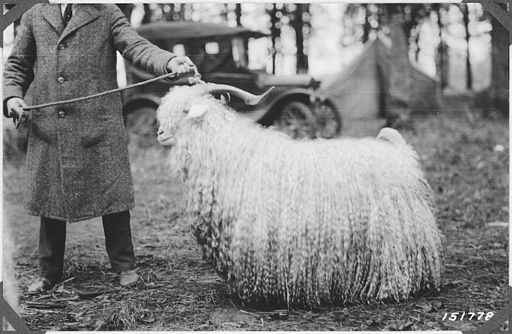Mohair – a Unique Goat

There are two types of fiber producing goats, goats that produce Cashmere and Angora goats that produce Mohair.
All domestic goats came from a single breed of goat still living today the Bezoar Ibex which produces Cashmere, or the down of the goat, in a near unusable amounts of fiber. Bezoar was domesticated by Neolithic farmers for milk, meat and tools.
Angora goats come from turkey the same location as Angora Rabbits, however when talking fiber, Rabbits make angora wool, and Angora Goats make mohair. An easy way to remember is that Goats have beards and therefore have (mo)hair.

Angora are not the heartiest breed of goat, prone to illness in colder climates after shearing, some believe it is due to their constant fiber production. They are not as prolific as other goat breeds, births being singles, and kids being delicate at birth. Angora are also more susceptible to internal parasites than other fiber producing livestock.

They are sheared twice a year, with adults growing at least ¾ an inch per month. The metabolic energy alone to constantly grow fiber is a considerable drain on the goats.
Mohair is classically white; however there is an ever developing market for natural colors. Colored angora is a redeveloping breed standard, for years the goats were breed for the clear brilliant white fiber, known to dye color true and radiant. There are two color divisions in angora blacks and reds. Blacks fleeces range from solid black to light grey and silver, while reds or “faded reds” are apricot to copper, becoming lighter, fading, but never to white as they age.
The Fiber: Angora’s fiber is affected by the goat’s age with their fibers become courser over time.

While it sounds like ages grow a single fiber range – an adult goat can grow a fleece with a 23 micron count and be classified as a kid, or a kid age goat can have a “good yearling” grade fleece.
The quick and dirty breakdown for wool spinners:
- Kid =Merino
- Yearling = Midrange wool
- Adult (heaviest) = English Longwools
-

Mohair takes dye readily and is luminescent with its lively colors, its capacity to dye is on par with that of silk.
Mohair has a smoother surface and very thin scale when compared to wool, making it lacking the felting properties but still allowing for matting of fibers. It is more durable then wool, it doesn’t pill and breaks less; however, it is more likely to be damaged during processing. All mohair that hasn’t been damaged in treatment is sleek and shiny with an elegant drape regardless of age. Mohair can be permanently stained, or damaged with alkaline or acidic baths when attempting to remove smell or natural discolorations.
Mohair production varies by the animal, with kids producing 1.5 to 3.5 lbs of fiber in their first shearing, while an adult buck can have up to 25lbs in a single shearing. The staple length is dependent on the age of the goat, with kids having at least a 3 inch staple and all other ages a 4-6inch staple.
Locks

There are two classes or types of locks, ringlets (C type) and flat lock hair (B type). Both locks have body and texture, however their structure and drape on the goat are different. Type B have flat, wavy locks that are generally bulkier and have a greater yield, but are likewise less fine. Type C are the finer, tight curls or ringlets. The yield of the clips from type C is lower than that of B, but the lock structure is tighter and often used for effects in in art yarns or when locks are showcased in textile arts.
Spinning the fiber

Strait mohair can feel especially slippery in drafting, take your time when you’re working with the fiber.
If you’re having troubles:
- Loosen the draw-in on your wheel –
- put enough twist to lock the fibers in but not so much that it becomes wiry –
- The perfect amount of twist will keep the slick fibers form shedding out of the yarn later.
In very-arid areas you might want to use a spritz of water (with or without as dash of olive oil to prevent static electricity) to help you control fly away hairs.
Mohair is most often blended into wool or silk, as 100% spun mohair yarn will stretch over time. If you want to blend a 70/30 mohair/wool try to get similar wool to that of your mohair it will create a solid and consistent look.
- Spin a fine single to worked as a ply, auto-wrap, or to be worked with a strand of a different fiber to add warmth and a halo of fibers.
- Blend with other fibers- adding a lustrous white or radiant color, in hand carded batts
- Core-spin the locks- create a tailspun yarn where the base of the locks are spun onto the core fiber, while the tips hang free.
- Embed the lock– into singles, plyed or not, to create bursts of halos, or tufts in the yarn
- Straight into weaving to add texture and dimension
Happy Spinning!

